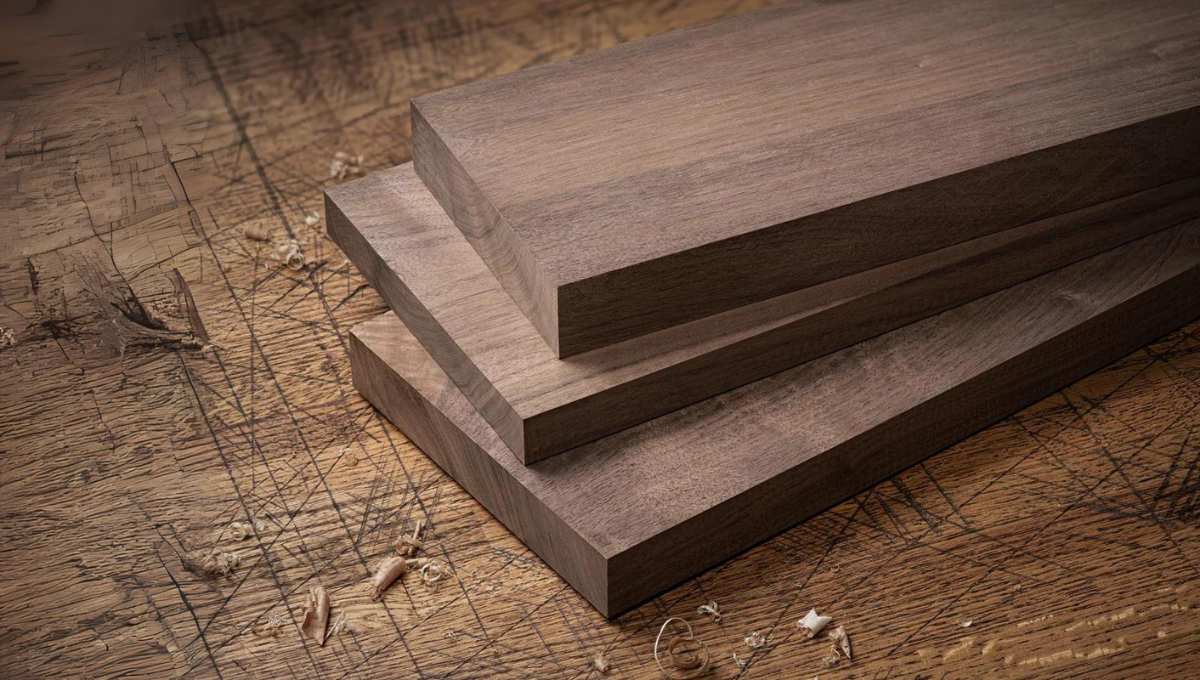Walnut wood is prized for its deep, rich tones and smooth texture, making it a favorite for luxury carpentry and high-end woodworking in Ireland and the UK. This guide explores the unique qualities of walnut that make it a standout choice for sophisticated projects.
Physical Properties
- Color: Walnut wood boasts a rich palette ranging from creamy whites in the sapwood to deep, chocolate browns in the heartwood, often accentuated with darker streaks that enhance its visual depth.
- Grain: Typically straight, walnut can also display wavy or curly patterns, offering a striking figure that adds to its decorative appeal.
- Texture: Known for its medium texture and moderate natural luster, walnut wood combines beauty with practicality in woodworking.
- Density: With a density of about 610 kg/m³, walnut provides substantial strength and durability, supporting both structural and aesthetic applications.
Mechanical Properties
- Strength and Durability: Walnut is robust, offering moderate strength in bending and crushing, with enough flexibility for a variety of applications.
- Hardness: Its Janka hardness rating of 1010 lbf allows walnut to withstand wear and tear, making it suitable for high-use areas like flooring.
- Decay Resistance: Naturally resistant to decay, walnut also stands up well to environmental challenges, though it may require periodic treatment to prevent insect damage.
Workability and Finishing
- Workability: Walnut is highly workable, responding well to cutting, shaping, and fastening, which makes it a joy for carpenters to use.
- Finishing: It accepts a wide range of finishes, from oil and wax to polyurethane, enhancing its color and protecting it from wear. Walnut can also be polished to a high gloss for an exquisite finish.
Unique Characteristics
- Aesthetic Versatility: Walnut’s rich color and diverse grain patterns allow it to fit seamlessly into both contemporary and traditional designs.
- Acoustic Properties: Favored for musical instruments due to its sound-enhancing qualities.
- Thermal Stability: Exhibits excellent dimensional stability, minimizing warping.
- Touch and Feel: Its smooth texture enhances the tactile experience of crafted items.
Practical Applications
- Fine Furniture: Ideal for crafting elegant furniture such as desks, chairs, and decorative cabinets that require a luxurious aesthetic.
- Flooring: Due to its durability and unique appearance, walnut is a top choice for premium residential and commercial flooring.
- Architectural Millwork: Used in detailed moldings, trims, and door panels, walnut adds sophistication to any architectural project.
- Specialty Items: Its attractive grain and color variability make walnut popular for musical instruments and fine gunstocks.
Sustainability and Sourcing
- Sourcing Challenges: While walnut is reasonably available, sustainable sourcing is crucial to preserve its availability. Choosing suppliers who adhere to responsible forestry practices, such as those certified by the FSC, ensures environmental stewardship.
- Environmental Impact: The use of walnut in carpentry supports sustainable forest management practices, particularly when sourced from managed forests in the Central Eastern United States.
Conclusion
Walnut wood embodies the pinnacle of luxury and sophistication in carpentry, offering unmatched beauty and durability for high-end projects. Its versatility makes it popular among carpenters and woodworkers in Ireland and the UK, ideal for those who seek quality and elegance in their woodworking endeavors.
For more detailed insights into walnut and other premium woods, visit our comprehensive guide to woods and finishes at Crafted Spaces Guide.

